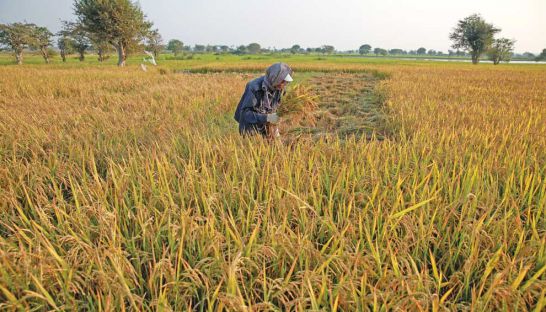No sign of relief for rice industry
No sign of relief for rice industry
As the harvest season of Cambodia’s most important crop kicks off, a crisis is looming as both rice farmers and millers face crippling capital shortages and a promised industry lifeline has yet to materialise.

Industry experts said yesterday that these small farmers desperate to pay their debt obligations have had no choice but to sell the harvested rice from their drought and flood-damaged fields at a loss. Meanwhile, millers unable to obtain bank finance are cutting back on purchases, pushing farm-gate prices even lower.
The sector’s best hope – a $20 million to $30 million package of government-backed emergency loans to help rice millers purchase paddy from farmers for processing or stockpiling – remains entangled in bureaucratic red tape. If the funds are not released by the end of the harvest in November, the economic and social impact could be immense.
“The only hope is for the government to approve the disbursement of loans so that [millers and storage depots] can buy paddy rice and help farmers resolve their issues before the end of the harvest season,” said Den Srey Lim, deputy director of Agricultural Development for Chamroeurn Phal, an agricultural cooperative in Battambang province.
“If there is no effective solution, farmers will face a serious crisis.”
According to Srey Lim, the market price of paddy rice in the province has fallen off steeply since the harvest began earlier this month. She said the farm-gate price on paddy had fallen from about $250 per tonne to $190 per tonne during the short time that farmers harvested the first 10 percent of their fields.
“Farmers are now facing high risk,” she said. “They are concerned that if the price of paddy remains low like this they will face losses and be unable to pay back their debts.”
She explained that most smallholding rice farmers borrow from microfinance institutions (MFIs) or fertiliser distributors at the start of the season to purchase seeds and fertiliser. The farmers have been particularly hard-hit this year as in addition to a sharp decrease in paddy rice prices, their crops were damaged by a prolonged drought and recent flooding.
Chhun Hang Lay, managing director of City Rice Import-Export, one of the biggest rice millers and exporters in Battambang province, said when rice farmers face issues their problems inevitably spread up the line.
“The farmer is the first person to face an issue, which then spreads to the rice miller, and soon the whole industry faces a crisis,” he said.
Lay said the market price on paddy rice had plummeted about 25 per cent to $230 per tonne since the start of the month. Yet despite the low price, millers including his own were cutting down on purchases due to a shortage of capital as banks had become more strict on extending credit.
“Most of the rice millers have tried to cut down on purchases and are buying only for export orders as they cannot afford to purchase for stockpiling,” he said, adding that some millers were holding out until the premium varieties of jasmine rice come onto the market next month. “This [lower demand] in turn impacts the farmers, as they cannot afford to store rice or wait [for paddy prices to rebound].”
In June, the Cambodia Rice Federation (CRF) announced that the government had agreed to disburse $20 million to 30 million in emergency loans through the CRF to its members to ensure that they had sufficient capital to purchase paddy rice from farmers this season. Yet even with the harvest already started, the fund are still nowhere to be seen.
Mey Vann, director of the financial industry department at MEF, declined to comment on the emergency loan package.
CRF finance manager Horn Theara offered two reasons for the hold-up, claiming that the Ministry of Economy and Finance (MEF) had still not authorised the disbursement of the funds, while the CRF, as guarantor of the loans, must carefully vet the recipients.
“We are trying to help our members because they need it, but because this is government money coming from private-sector taxation collection we also need to ensure that millers can repay their loans,” he said. “It is a difficult balance to achieve.”
Theara said that while he was unsure when the funding would begin, MEF was insisting that millers put down rice paddy stock as collateral in order to qualify for loans. This has created a catch-22.
“Millers do not have enough working capital to purchase rice paddy stock at the moment,” he said, adding that he hoped MEF would recognise the urgency of the situation.
“The CRF needs to convince MEF that there are millers that are big enough and able to be profitable, and who thus deserve funding,” he said. “The $20 million to $30 million will not be enough, but we hope that once lending begins, this will just be the first phase of many to shore up the industry.”
Theara said with the government loan package tied up in red tape, the CRF was desperately reaching out to the Kingdom’s biggest commercial banks for credit facilities – but stumbling once again on collateral.
“The banks are also reluctant to lend because it is risky and they are not confident they will be paid back,” he said. “The banks want the millers to put down rice paddy stock for collateral as well before they consider lending.”













